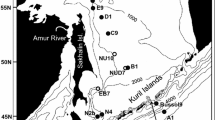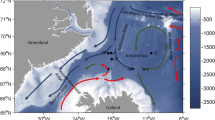Abstract
During the Winter Weddell Gyre Study in September–October 1989, the horizontal and vertical distribution, stage composition and feeding condition of the three antarctic copepod species Calanoides acutus, Rhincalanus gigas and Calanus propinquus were studied. The data indicate that C. acutus and R. gigas have the bases of their distributional ranges (sensu Makarov et al. 1982) in the Antarctic Circumpolar Current (ACC) and in the Warm Deep Water (WDW) entering the Weddell Gyre (WG). C. propinquus lived mainly in the cold WG south of the ACC. C. acutus overwintered mainly in the WG as stage IV copepodites (C). The species mainly inhabited the layers below the Tℴmax stratum and down to 2000 m, but C V and females occurred slightly higher than C III and IV. Males prevailed over females and were confined to a rather narrow layer between 500 and 1000 m. Feeding experiments suggested all deep-living stages to be resting. However, if this species spawns in late autumn the younger C I–II can stay in the Winter Water (WW). R. gigas inhabited mainly the Tℴmax stratum. In the eastern part of the WG, R. gigas breed in the WDW in autumn and hibernate as C I–III and C V–VI in the first and second winter, respectively. In the ACC zone, however, its life cycle is different and winter breeding of overwintered adults occurs. Most of the C. propinquus population overwintered in the WG as C III–V, inhabiting the WW. In the upper water layers in the interior of the WG, C III dominated with upto 18,000 individuals 1,000 m3. Shallow living C. propinquus were in the active, feeding state. Persistence of active feeding zooplankton populations in the WW of the WG can be an important factor influencing processes of phytoplankton development and the particle flux.
Similar content being viewed by others
References
Andrews KJH (1966) The distribution and life history of Calanoides acutus (Giesbrecht). Discovery Rep 34:117–162
Arashkevich EG (1978) Some characteristics of the copepod feeding (in Russian). Tr Inst Okeanol 112:118–125
Atkinson A (1991) Life cycles of Calanoides acutus, Calanus simillimus and Rhincalanus gigas (Copepoda: Calanoida) within the Scotia Sea. Mar Biol 109:79–91
Augstein E, Bagriantsev N, Schenke HW (eds) (1991) The expedition ANTARKTIS VIII/1–2, 1989 with the Winter Weddell Gyre Study of the research vessels “Polarstern” and “Akademik Fed orov”. Ber Polarforsch 84:1–133
Bagriantsev NV, Sarukhanian EI (1984) The Weddell Polynia as a consequence of the hydrophysical processes in the Weddell Gyre (in Russian). Dokl Acad Nauk SSSR 276:1238–1242
Bagriantsev NV, Gordon AL, Huber BA (1989) Weddell Gyre: Temperature maximum stratum. J Geophys Res 94:8331–8334
Bathmann UV (1992) Feeding rates of Calanus propinquus and Calanoides acutus. In: Bathmann UV, et al. (eds) Die Expedition Anarktis IX/1-4 des Forschungschiffes Polarstern 1990/91. Ber Polarforsch 100:184–185
Bathmann UV, Noji TT, Bodungen B von (1990) Copepod grazing potential in late winter in the Norwegian Sea — a factor in the control of spring phytoplankton growth? Mar Ecol Progr Ser 60:225–233
Bathmann UV, Schulz-Baldes M, Fahrbach E, Smetacek V, Hubberten W-H (eds) (1992) The Expeditions ANTARKTIS IX/1–4 of the Research Vessel “Polarstern” in 1990/91. Ber Polarforsch 100:403 pp
Beklemischev KV (1969) Ecology and biogeography of the pelagial (in Russian). Nauka Moscow: 1–291
Bergstrøm BI, Hempel G, Marschall HP, North A, Siegel V, Strömberg JO (1990) Spring distribution, size composition and behavior of krill Euphausia superba in the Western Weddell Sea. Polar Rec 26(157):85–89
Bondarenko MV, Polonsky VE (1990) Distribution and seasonal composition of plankton at the section along 10° E in relation to hydrological conditions. In: Makarov RR, et al. (eds) Investigations of the Weddell Gyre. Oceanographic conditions and peculiarities of the development of plankton communities (in Russian). VNIRO Publications, Moscow, pp 125–139
Boysen-Ennen E (1987) Zur Verbreitung des Meso- und Makrozooplankton in Oberflächenwasser der Weddell See (Antarktis). Ber Polarforsch 35:1–126
Boysen-Ennen E, Piatkowski U (1988) Meso- and makrozooplankton communities in the Weddell Sea, Antarctica. Polar Biol 9:17–35
Comiso JC, Gordon AL (1987) Recurring polynyas over the Cosmonaut Sea and the Maud Rise. J Geophys Res 92:2819–2834
Conover RJ (1988) Comparative life-histories in genera Calanus and Neocalanus in high latitudes of the Northern Hemisphere. Hydrobiologia 167/168:127–142
Drits AV, Pasternak, AF, Kosobokova KN (1992) Feeding, metabolism and body composition of the antarctic copepod Calanus propinquus Brady with special reference to its life cycle. Polar Biol, in press
Evans CA, O'Reilly JE, Thomas JP (1987) A handbook for the measurement of chlorophyll a and primary production. BIO-MASS Sci Ser 8:114 pp
Fahrbach E, Knoche M, Rohardt G (1991) An estimate of water mass transformation in the southern Weddell Sea. Mar Chem 35:24–44
Fahrbach E, Rohardt G, Krause G (1992) The Antarctic Coastal Current in the Southeastern Weddell Sea. Polar Biol (in press)
Fahrbach E, Augstein E, Olbers D (1993) Impact of shelf and sea ice on the water mass modification and the large scale oceanic circulation in the Weddell Sea. In: Hempel G (ed) Antarctic Science Global Concern SCAR-symposium proceedings (in press)
Foster TD, Carmack EC (1976) Temperature and salinity structure in the Weddell Sea. J Phys Oceanogr 6:36–44
Fransz HG (1988) Vernal abundance, structure and development of epipelagic copepod populations of the Eastern Weddell Sea (Antarctica). Polar Biol 9:107–114
Fukuchi M, Sasaki H (1981) Phytoplankton and Zooplankton standing stocks and downward flux of particulate material around fast ice edge of Lützow-Holm Bay, Antarctica Mem Natl Inst Polar Res Ser E Biol Med Sci 34:13–36
Gordon A, Comiso JC (1988) Polynias in the Southern Ocean. Sci Am 256:89–96
Gordon AL, Huber BA (1984) Thermohaline stratification below the Southern Ocean sea ice. J Geophys Res 89:641–648
Gordon AL, Huber BA (1990) Southern Ocean winter mixed layer. J Geophys Res 95:11,655–11,672
Gouretski VV, Danilov AI (1992) Weddell Gyre: structure of the eastern boundary. Deep-Sea Res (in press)
Hirche HJ (1983) Overwintering of Calanus finmarchicus and Calanus helgolandicus. Mar Ecol Progr Ser 11:281–290
Hopkins TL, Torres JJ (1989) Midwater food web in the vicinity of a marginal ice zone in the Western Weddell Sea. Deep-Sea Res 36:543–560
Hosie GW, Stolp M (1989) Krill and Zooplankton in the western Prydz Bay region, September–November 1985. Proc Natl Inst Polar Res Symp Polar Biol 2:34–45
Klepikov VV (1963) Hydrology of the Weddell Sea (in Russian). Tr Sov Antarkt Eksped 17:45–93
Lange MA, Ackley SF, Wadhams P, Dieckmann GS, Eicken H (1989) Development of sea ice in the Weddell Sea. Ann Glaciol 12:92–112
Makarov RR, Solyankin EV (1990) Common copepod species and regional peculiarities of their seasonal development in the east area of the Weddel Eyre. In: Solyankin EV, et al. (eds) Investigations of the oceanographic conditions and peculiarities of the development of plankton communities (in Russian). VNIRO Publication, Moscow, pp 140–167
Makarov RR, Maslennikon VV, Movchan OA, Solyankin EV (1982) Oceanographic conditions and regional peculairities of seasonal successions in plankton of the coastal waters of Antarctic Peninsula (in Russian). Antarctica 21:101–117
Makarov RR, Menshenina LL, Spiridonov VA (1987) On the studies of plankton distribution and its biological seasonal activity in the central and western areas of the Antarctic Pacific sector. In: Makarov RR, et al. (eds) Studies in the biological oceanography of the Pacific sector of the Antarctic (in Russian). VNIRO Publication, Moscow, pp 90–110
Makarov RR, Maslennikov VV, Menshenina LL (1990) Frontal zones as ecological boundaries in the Antarctic waters. In: Solyankin EV, et al. (eds) Investigations of the Weddell Gyre. Oceanographic conditions and peculiarities of the development of plankton communities (in Russian). VNIRO Publications, Moscow, pp 99–124
Marin V (1987) The oceanographic structure of the Eastern Scotia Sea IV. Distribution of copepod species in relation to hydrography. Deep-Sea Res 34:105–121
Marin V (1988a) Independent life cycles: an alternative to the asynchronism hypotheses for Antarctic calanoid copepods. Hydrobiologia 167/167:161–168
Marin V (1988b) Qualitative models of the life cycles of Calanoides acutus, Calanus propinquus, and Rhincalanus gigas. Polar Biol. 8:439–446
Marschall HP (1988) The overwintering strategy of Antarctic krill under the pack-ice of the Weddell Sea. Polar Biol. 9:129–135
Melnikov IA (1984) On the peculiarities of distribution and behavior of the common species of cryopelagic fauna under the drifting Arctic ice (in Russian). Zool Zh 63:86–89
Naumov AG (1973) Ecological characteristics of the common Zooplankton species in the Pacific sector of the Antarctic (in Russian). Tr VNIRO 84:139–147
Nöthig E-M, Gowing MM (1991) Late winter abundance and distribution of phaeodarian radiolarians, other large protozooplankton and copepod nauplii in the Weddell Sea, Antarctica. Mar Biol 111:473–484
Nöthig E-M, Bathmann U, Jennings JC, Fahrbach E, Gradinger R, Gordon LI, Makarov RR (1991) Regional relationship between biological and hydrographical properties in the Weddell Gyre in late austral winter 1989. Mar Chem 35:325–336
O'Brien DP (1987) Direct observations on the behavior of Euphausia superba and Euphausia crystallorophias under pack-ice during the Antarctic spring of 1985. J Crust Biol 7:437–448
Ommaney FD (1936) Rhincalanus gigas (Brady) a copepod of the southern macroplankton. Discovery Rep 13:277–384
Omori M, Ikeda T (1984) Methods in marine Zooplankton ecology. Wiley and Sons, New York, 332 pp
Paffenhöfer G-A (1971) Grazing and ingestion rates of nauplii, copepodits and adults of the marine planktonic copepod Calanus helgolandicus. Mar Biol 11:286–298
Schiel S (1991) Zooplankton/Krill. In: Huntley M, Hofmann E (eds) GLOBEC Workshop on Southern Ocean marine animal populations and climate change, La Jolla, November 1991 pp 28–40
Schnack-Schiel SB, Hagen W, Mizdalski E (1991) Seasonal comparison of Calanoides acutus and Calanus propinquus (Copepoda: Calanoida) in the south-eastern Weddell Sea (Antarctica). Mar Ecol Progr Ser 70:17–27
Spiridonov VA (1992) Distribution and biological properties of the Antarctic krill Euphausia superba Dana during Winter Weddell Gyre Study (WWGS) 1989. Proc Natl Inst Polar Res Symp Polar Biol 5:55–64
Spiridonov VA, Gruzov EN, Pushkin AF (1985) Investigations of schools of Antarctic krill Euphausia superba under ice (in Russian). Zool Zh 64:1655–1661
Vladimirskaya EV (1978) Age composition of populations of abundant copepod species in the Southern Scotia Sea. Oceanology 18:202–204
Vladimirskaya EV, Makarov RR, Solyankin EV (1988) Reproductive ecology of mass copepods at high latitudinal regions of the Antarctic Ocean (in Russian). Antarctica 27:142–159
Voronina NM (1970) Seasonal cycles of some common Antarctic copepod species. In: Holdgate MV (ed) Antarctic Ecology, vol 1. Academic Press, London, pp 162–172
Voronina NM (1972) The spatial structure of interzonal copepod populations in the Southern Ocean. Mar Biol 15:336–343
Voronina NM (1975) On the ecology and biogeography of the plankton in the Southern Ocean (in Russian). Tr Instituta Okeanol Acad Nauk SSSR 103:60–87
Voronina NM (1984) Ecosystems of the pelagial of the Southern Ocean (in Russian). Nauka Moscow 1–206
Voronina NM, Vladimirskaya EV, Zmijevska MI (1978) Seasonal variations in the age composition and vertical distribution of common Zooplankton species in the Southern Ocean. Oceanology 18:335–338
Author information
Authors and Affiliations
Rights and permissions
About this article
Cite this article
Bathmann, U.V., Makarov, R.R., Spiridonov, V.A. et al. Winter distribution and overwintering strategies of the Antarctic copepod species Calanoides acutus, Rhincalanus gigas and Calanus propinquus (Crustacea,Calanoida) in the Weddell Sea. Polar Biol 13, 333–346 (1993). https://doi.org/10.1007/BF00238360
Received:
Accepted:
Issue Date:
DOI: https://doi.org/10.1007/BF00238360




